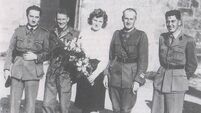A fleeting glimpse of a wise old friend
Oh, for the owl and the snow! At seven o’clock the other evening, a farmer and nature-watcher I know phoned to say that as he and his young son finished milking, the boy saw a ghostly bird fly over the yard.
The yard adjoins the old farmhouse on their land, now in ruins. Was it an owl?, he asked. From his description, I had little doubt. Furthermore, he reminded me that I had written an article about a barn owl I saw in that vicinity some 13 years ago. I haven’t seen another since. It was the last barn owl I ever saw in Ireland.
Barn owls are now very rare. When I was a child, my father sometimes brought them home, owls he had found stunned or damaged where they had flown into the headlights of cars. There were more barn owls than cars then, in rural Ireland.
We would put them in the big, empty rooms that always seemed to attach to the bank houses where we lived. Sometimes, they would recover.
Sometimes, I tried to feed them mice, captured by myself and friends.
Once, when I was very young, the owl we had put in a closed room the night before was gone in the morning. I was mystified. Then, my father pointed to the chimney, and we looked up it, and saw the blue sky far above.
I telephoned Tony Nagle of BirdWatch Ireland, Cork Branch, to report the sighting. For over a decade, he has been studying barn owls and trying to conserve them by providing nest boxes where their habitat is threatened or gone. He was pleased to hear there might be an owl back in the territory. He told me that of 25 sites occupied in the early 1990s, only 10 were now occupied. The knocking of ruins or replacement of old barns with new, metal structures was often to blame but sometimes, they disappeared for no apparent reason. Something subtle had changed. The owls noticed, we didn’t. They are, of course, wise and in touch.
The farmer told me that he had grown fields of corn nearby, and that rats had arrived in droves; dozens had run out when the corn was being harvested. Foxes had shown up to feast on the rats; he saw them too. The foxes, hiding amongst the foliage, would sometimes pick off a crow, also drawn to the corn.
Rats remained when the corn was cut, foraging for heads and grains left by the harvester. Now, there was an owl to prey on the rats. It had a ruin to live in, a tree to perch in and, as long as they lasted, a diet of corn-fed rats. When the rats had moved on, there might be voles. Bank voles, barn owls’ favourite prey, are now common in West Cork.
It was 15 years ago that I learned this. I wrote about it in the Examiner at the time. If any readers remember, I beg their indulgence.
It is a tale worth retelling.
I hadn’t long moved back to Ireland. On an earlier visit, I’d read in “The Fauna of Ireland” by Fergus O’Rourke, that bank voles (common in Britain, with four species) had been reported in Kerry in 1964, having possibly arrived in ships’ cargo.
One day, then, in 1990, my junior son, aged five, came running into the house telling me that the cat had caught a mouse and he’d rescued it and put it in an aquarium (dry, at the time) and would I come and look because it was lovely. I duly did and was excited to see that this mouse had no tail, ears buried in its dense reddish fur and a quite unmouselike profile. It was a bank vole: we’d maybe found the first bank vole in West Cork! I phoned Cork University and left an urgent message at the Zoology Department. I didn’t want to keep the creature captive too long in case, it — the only vole ever found in West Cork — might die. Later, a zoologist phoned me. “It’s a bank vole,” I said, “in West Cork!”
“Really,” he answered, his strong city accent loaded with ennui,
“Sure, we have them here in the city all the time...”
I was, of course, amazed at how quickly small, furry voles, on their short legs, had spread. Since then, I’ve seen the Little Egret, a beautiful and elegant bird of which I saw a single vagrant specimen in 1990, become common on my local estuary.
It would now be wonderful, but perhaps too much to hope, that the barn owl, graceful ghost of the night, would become a common sight again.












